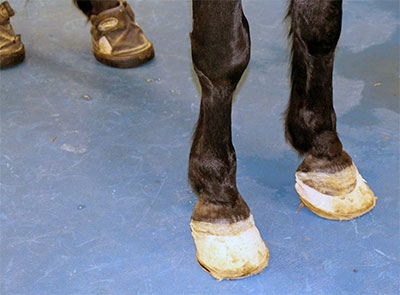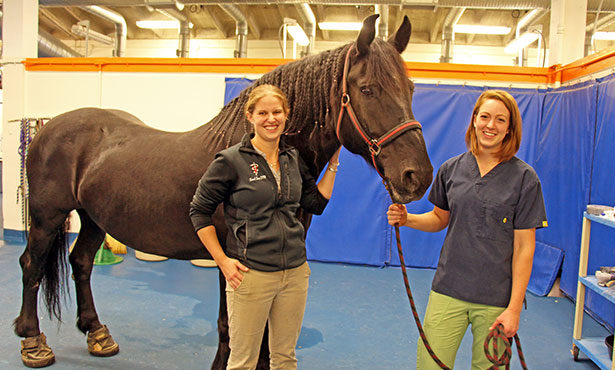Pictured Above: Equine veterinarian Erica Secor and 4th-year veterinary student Nicole Thomas applied special shoe covers on Xena’s feet (below) that hold bandages and medication in place.
The word “canker” just sounds unpleasant, and to the horses that it affects, it is.
Erica Secor, a veterinarian who is completing a 3-year residency program in equine surgery at the University of Illinois College of Veterinary Medicine, explains that canker “is the horseman’s term for proliferative pododermatitis.”
Secor has a particular interest in horse hoof issues and care. In fact, she trained as a farrier (a person who shoes horses and cares for their feet) before she became a veterinarian.
What Is Canker?
Canker is a chronic infection of the frog of the hoof. The frog is the soft, cushioned area at the rear of the sole of the horse’s hoof. The infection that sets in is often anaerobic, meaning it doesn’t require oxygen to survive. As the body’s natural immune defense tries to ward off the infection, a white irregular tissue develops. The foot also produces a white smelly discharge, and the horse has difficulty walking because its feet are sore.
“The farrier may also notice that the feet will bleed easily and the horse may be less tolerant of the shoeing process because of pain from the infection,” Secor says.
 Canker is most commonly found in draft horses, but veterinarians aren’t sure why.
Canker is most commonly found in draft horses, but veterinarians aren’t sure why.
“It could be because draft horses have large feet with deep crevices that are more susceptible to infection,” she says, “or they may have a genetic predisposition to this infection, or it could be a combination of these reasons.”
Horses that have been exposed to a wet environment, such as damp bedding in a stall, also are more likely to develop canker.
How Is Canker Treated?
“Oral antibiotics don’t really touch proliferative pododermatitis, because when giving a medication like that orally, not enough of it gets to the foot,” says Secor. “The mainstay of treatment is topical medications, such as benzoyl peroxide, a compound found in many acne face washes. This works well to dry out tissue.”
Veterinarians may also try surgical debridement, the process of cutting away the abnormal, infected tissue using a scalpel blade, according to Secor. This procedure may be done while the horse is under general anesthesia, especially if a large portion of tissue is removed; alternatively, it can be performed while the horse is standing and the foot is numbed with a local block.
“Even if a significant portion of the frog is removed, horses generally adjust well and usually the frog grows back within 6 months,” Secor says.
After the surgical debridement procedure, the horse’s hooves are protected with a pad and bandages. A hospital plate is bolted onto the horse’s shoe to keep bandages and medication in place.
Prevent Canker
Canker is often chronic, and relapses may occur after treatment. The best way to prevent canker is to keep bedding clean and dry and pick out the horse’s feet often.
“If you notice that your horse is sensitive to having its feet touched, has discharge, or has strange-looking tissue, call your veterinarian immediately,” advises Secor. “The home remedies promoted on the Internet don’t often work and just allow the condition to worsen. Canker is most easily treated when it is caught early. Talk to your veterinarian, who can help you make sure your horse’s feet are healthy and canker-free.”








Post a comment
Report Abusive Comment